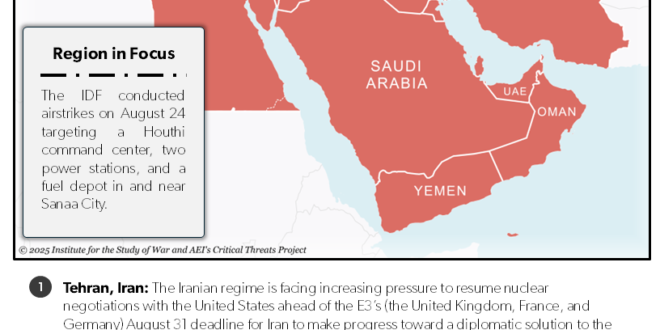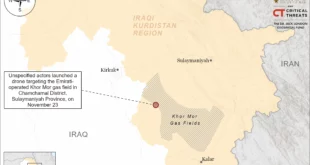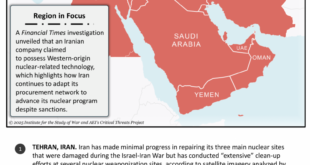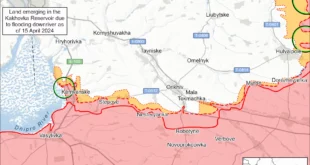Iranian Supreme Leader Ali Khamenei rejected recent calls by Iranian reformist officials to reform Iran’s domestic and foreign policies.[1] Khamenei delivered a speech on August 24 in which he claimed that “Iran’s enemies” failed to defeat Iran during the Israel-Iran War and are now trying to do so by “creating discord in the country.”[2] Khamenei claimed that agents of the United States and Israel, along with “heedless speakers and writers,” are creating division.[3] Khamenei may have used the term “heedless speakers and writers” to refer to reformist officials who have recently called on the regime to reform its domestic and foreign policies. Former Iranian President Hassan Rouhani called on August 13 for the regime to make concessions to the Iranian people, strengthen societal resilience, and reduce tensions with the West.[4] The Iranian Reformist Front separately issued a statement on August 17 that called for political reforms and foreign policy shifts, including suspending uranium enrichment under International Atomic Energy Agency (IAEA) oversight.[5] Khamenei rejected this and similar calls to engage with the United States in his speech on August 24, stating that the conflict between Iran and the United States is “unsolvable.” Khamenei additionally rejected direct talks with the United States but did not explicitly rule out the possibility of indirect negotiations.
The Iranian regime is facing increasing pressure to resume nuclear negotiations with the United States ahead of the E3’s (the United Kingdom, France, and Germany) August 31 deadline for Iran to make progress toward a diplomatic solution to the nuclear issue. An Iranian delegation led by Deputy Foreign Affairs Minister for Political Affairs Majid Takht Ravanchi will meet with E3 officials in Geneva, Switzerland, on August 26 to continue talks over potential snapback sanctions.[6] British Foreign Secretary David Lammy stated on August 22 that the E3 will activate the snapback mechanism to reimpose United Nations Security Council (UNSC) sanctions on Iran unless Iran agrees to a “verifiable, durable deal.”[7] A senior French diplomat told Saudi media on August 25 that the meeting in Geneva would be the “last window open to the Iranian side.”[8] The E3 imposed a deadline of August 31 on Iran to make meaningful progress toward a nuclear deal, such as by renewing cooperation with the International Atomic Energy Agency (IAEA) and resuming negotiations with the United States.[9] The E3 offered to postpone the expiration of the snapback mechanism to allow Iran more time to negotiate with the United States.[10] The snapback mechanism is currently set to expire in October 2025. Iranian officials have rejected postponing the deadline because extending the deadline would provide the E3 with more time to trigger the snapback mechanism. The E3 would need to initiate the snapback process by September 3 in order to complete the process by the current October deadline.[11] The snapback mechanism would reimpose six UNSC resolutions on Iran, including bans on the transfer of conventional arms to and from Iran, international support for Iran’s missile program, enrichment-related activities, and the testing and development of nuclear-capable missiles.[12]
Iranian Supreme National Security Council (SNSC) Secretary Ali Larijani is reportedly trying to convince the Iranian regime to reduce Iran’s level of uranium enrichment from 60 percent to 20 percent to avoid snapback sanctions and further US and Israeli strikes, according to a senior Iranian official speaking to The Telegraph on August 24.[13] The senior official stated that Larijani is concerned that another war with the United States or Israel could present a major challenge to the regime.[14] Larijani reportedly faces the most opposition from Islamic Revolutionary Guards Corps (IRGC) members.[15] The official also stated that Iranian leaders appear “willing to comply” with Larijani’s call to reduce enrichment levels and re-engage with Western countries.[16] The Washington Post similarly reported on July 13 that there is a “consensus” among Iran’s political class that Iran needs to resume nuclear negotiations with the United States, citing political observers inside and outside of Iran.[17]These reports suggest that Iranian moderates who support nuclear negotiations with the United States are continuing to prevail over Iranian hardliners who reject negotiations. Larijani replaced Ali Akbar Ahmadian as SNSC secretary on August 5 as part of a broader restructuring of Iranian defense and security institutions after the Israel-Iran War. Larijani is a moderate politician who supported the 2015 Joint Comprehensive Plan of Action (JCPOA).
Russia reportedly introduced a draft resolution to extend the snapback mechanism deadline, according to unspecified informed sources speaking to UK-based Amwaj Media on August 25.[18] The informed sources stated that China will reportedly co-sponsor the draft resolution.[19] The draft resolution would extend the snapback deadline by six months until April 2026 and reportedly prevent the E3 from being able to trigger the snapback mechanism during the six-month extension period.[20] Iran previously rejected an offer by the E3 to extend the snapback deadline, so it is unclear whether Iran will support the Russian draft proposal.[21] This report comes after Iranian President Masoud Pezeshkian and Iranian Foreign Affairs Minister Abbas Araghchi held separate phone calls with their Russian counterparts, President Vladimir Putin and Foreign Affairs Minister Sergei Lavrov, respectively, to discuss, among other issues, potential snapback sanctions.[22] Iranian Deputy Foreign Minister for Legal and International Affairs Kazem Gharibabadi called Chinese Vice Foreign Minister Ma Zhaoxu on August 24 to discuss a diplomatic resolution to the nuclear issue.[23]
Iranian-backed Iraqi militia Asaib Ahl al Haq leader Qais al Khazali used popular fears about an Islamic State of Iraq and Syria (ISIS) resurgence to try to justify the existence of the Iranian-backed Popular Mobilization Forces (PMF). Recent US political and economic pressure on the Iraqi federal government to curb Iranian influence in Iraq has sparked a debate in the Iraqi political space about the future and possible dissolution of the PMF.[24] The PMF was established in 2014 by “institutionalizing” pre-existing and predominantly Shia militias, including various Iranian-backed Iraqi militias like Asaib Ahl al Haq, that were engaged in the fight against ISIS.[25] Khazali argued on August 23 that unspecified current events are “more dangerous” than the situation before ISIS’s emergence in 2014.[26] He added that “takfiri” fighters are operating on Iraq’s borders. Khazali was likely referring to ISIS fighters who continue to operate in northeastern Syria. Khazali may seek to amplify the threat that ISIS poses to Iraq to prevent the PMF’s dissolution. The spokesperson for Iraqi Prime Minister Mohammad Shia al Sudani asserted on August 23 that ISIS no longer poses a threat to Iraq.[27]
It is possible that Khazali was also referring to Syrian government forces, which control territory immediately along the Iraqi border at the Albu Kamal-al Qaim border crossing.[28] Iranian-backed Iraqi actors have remained intensely distrustful of the Syrian transitional government under President Ahmed al Shara due to Shara’s historic ties to al Qaeda in Iraq, which was the predecessor to ISIS.[29]Iranian Supreme Leader Ali Khamenei’s Adviser to Iraq, Mojtaba Hosseini, similarly claimed on August 23 that the United States wants Iraq to “suffer the same fate as Syria.”[30] Iran viewed the overthrow of the Assad regime in December 2024 as part of a US effort to replace a pro-Iranian government with one led by “terrorists” under Syrian President Ahmed al Shara.[31] The Iranian regime has historically accused the United States of creating and supporting terrorist actors like ISIS to undermine Iran and its Axis of Resistance.[32]
Khazali and Hosseini’s comments come amid continued US efforts to dissolve the PMF. Iraqi Parliament Speaker Mahmoud al Mashhadani stated on August 24 that the United States warned several Iraqi officials, including Iraqi President Abdul Latif al Rashid, that the United States will take a “different position” if the Iraqi Parliament passes laws that oppose US laws, in reference to the Popular Mobilization Authority Law.[33] The Popular Mobilization Authority Law, which the Iraqi Parliament has not yet voted on, includes provisions to make the PMF chairmanship a ministerial position and professionalize the PMF as a fighting force.[34] An “informed source” told Iraqi media on August 23 that a senior US delegation will visit Baghdad in the coming days to discuss the US military withdrawal from Iraq as well as unspecified energy and economic issues.[35] The United States is expected to complete the first phase of its withdrawal from Iraq to the Iraqi Kurdistan Region by the end of September 2025.[36] The recent US pressure on the Iraqi federal government to curb Iranian influence in Iraq has included demands for the Iraqi government to curb Iranian oil smuggling, which could be discussed by the US delegation visiting Iraq.
Druze leader Hikmat al Hijri’s unification of around 40 Druze militias into the “National Guard” to defend Suwayda Province on August 23 undermines the Syrian transitional government’s efforts to establish a centralized Syrian state.[37] Hijri formed an autonomous government in Suwayda Province on August 6.[38] The militias that have merged to form the “National Guard” include prominent Druze militias, such as the Unification Shield, which includes 23 battalions, the Men of Dignity, Liwa al Jibal, the Unified Popular Resistance, the Southern Shield Forces, the Mountain Shield Forces, the Sheikh al Karama Forces, and the 164th Brigade. The Men of Dignity militia was previously open to cooperation with the Syrian transitional government but rejected government control over Suwayda Province after government forces committed atrocities against Druze civilians in July.[39] Hijri commended the creation of the “National Guard” and the “Supreme Legal Committee” and claimed that these institutions serve as the security, military, political, and legal apparatuses of Suwayda Province.[40]
The newly-formed “National Guard” and “Supreme Legal Committee” include several former Assad-era officers.[41] The Suwayda “National Guard” includes Brigadier General Jihad Ghoutani, who previously served as an artillery commander under Assad after his promotion in 2019.[42] Ghoutani fought for the Assad regime in battles across Syria, including artillery campaigns in Rif Dimashq, Idlib, and Homs provinces.[43] Suwayda’s “Supreme Legal Committee” appointed former Assad intelligence officer Brigadier General Shakib Ajoud Nasr, who oversaw political security in Tartous, as head of internal security on August 6.[44] The “Supreme Legal Committee” later replaced Nasr with a Suwaydawi judge on August 12.[45]
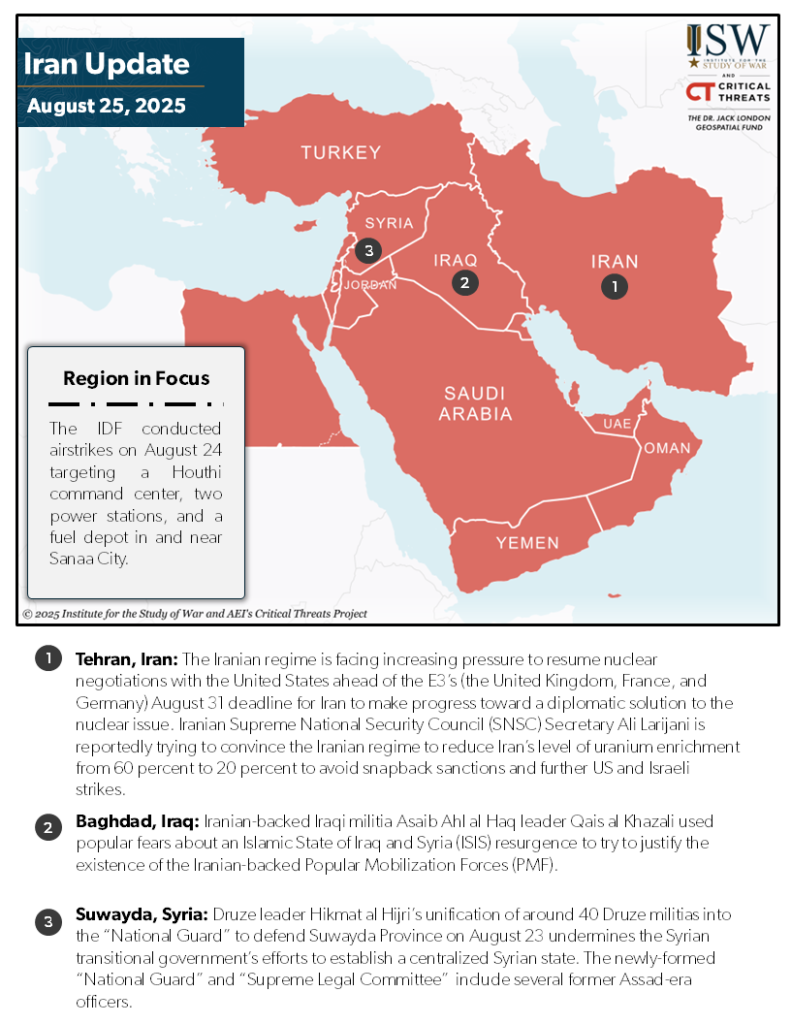
Key Takeaways
Baghdad, Iraq: Iranian-backed Iraqi militia Asaib Ahl al Haq leader Qais al Khazali used popular fears about an Islamic State of Iraq and Syria (ISIS) resurgence to try to justify the existence of the Iranian-backed Popular Mobilization Forces (PMF). Recent US political and economic pressure on the Iraqi federal government to curb Iranian influence in Iraq has sparked a debate in the Iraqi political space about the future and possible dissolution of the PMF.
Tehran, Iran: The Iranian regime is facing increasing pressure to resume nuclear negotiations with the United States ahead of the E3’s (the United Kingdom, France, and Germany) August 31 deadline for Iran to make progress toward a diplomatic solution to the nuclear issue. Iranian Supreme National Security Council (SNSC) Secretary Ali Larijani is reportedly trying to convince the Iranian regime to reduce Iran’s level of uranium enrichment from 60 percent to 20 percent to avoid snapback sanctions and further US and Israeli strikes.
Suwayda, Syria: Druze leader Hikmat al Hijri’s unification of around 40 Druze militias into the “National Guard” to defend Suwayda Province on August 23 undermines the Syrian transitional government’s efforts to establish a centralized Syrian state. The newly-formed “National Guard” and “Supreme Legal Committee” include several former Assad-era officers.Iran
Iranian Deputy Foreign Affairs Minister for Legal and International Affairs Kazem Gharibabadi held separate meetings with senior clerics Nasser Makarem Shirazi and Hashem Hosseini Bushehri in Qom on August 21 to discuss foreign policy developments.[46] Makarem Shirazi praised the Foreign Affairs Ministry as “awake and well aware of its duty.”[47] Makarem Shirazi added that the ministry should fight Iran’s adversaries on the diplomatic front just as the Iranian armed forces fight Iran’s adversaries on the battlefield.[48] Bushehri separately linked diplomacy to military strength and endorsed conditional negotiations.[49] Bushehri called negotiations a “rational matter” with Islamic precedent, stressing that peace is acceptable so long as it preserves Islamic values.[50]
Iranian security forces thwarted a terrorist plot on August 25, according to the Iranian Intelligence Ministry.[51] The Intelligence Ministry claimed that Iranian security forces destroyed a terrorist cell that had entered Iran from its eastern border and was armed with rocket-propelled grenades, machine guns, grenades, explosive vests, and large quantities of ammunition.[52] Iranian authorities claimed that the cell planned to attack a “vital site” in eastern Iran and compared the target to military targets that Israel struck during the 12-day war.[53] Iranian authorities accused the cell of links to Mossad.[54] The Iranian regime has previously accused Israel of supporting Jaish al Adl.[55] Jaish al Adl is a Baloch Salafi-jihadi group that frequently conducts attacks, primarily targeting Iranian security sites and personnel, in southeastern Iran.[56] Iranian security forces killed six fighters and detained two others while thwarting the plot.[57] The Intelligence Ministry added that two of its officers and one Law Enforcement Command (LEC) officer were injured.[58] This announcement follows a string of attacks and counterterrorism operations against Jaish al Adl in Sistan and Baluchistan Province in recent weeks.[59]
Iraq
See topline section.
Syria
The Syrian transitional government’s Supreme Committee for People’s Assembly Elections outlined criteria for the formation of provincial subcommittees on August 23.[60] The Syrian transitional government will hold its first parliamentary elections through provincial subcommittees between September 15 and 20, 2025.[61] The Supreme Committee separately announced on August 23 that elections in Suwayda, Raqqa, and Hasakah provinces will be postponed because the government lacks control over these provinces.[62] The committee clarified that these provinces will retain their current seat allocations and that elections will take place in these provinces as soon as possible.[63] CTP-ISW previously assessed that the new parliament is unlikely to check President Ahmed al Shara’s power, given that Shara directly appoints one-third of the People’s Assembly’s members and indirectly influences the selection of the remaining two-thirds.[64]
Arabian Peninsula
The Houthis launched two drones targeting military and “vital” sites in Tel Aviv and Ashkelon, as well as a missile targeting Ben Gurion Airport on August 22.[65] The Israel Defense Forces (IDF) confirmed on August 22 that the missile “disintegrated in the air” after Israeli air defense systems made several interception attempts. Debris from the missile fell in central Israel, causing minor damage but no casualties.[66] The IDF stated on August 22 that it is still investigating the incident. The Houthis have launched hundreds of drones and ballistic missiles targeting Israel since the Houthis began their campaign to enforce an economic “blockade” on Israel in October 2023.[67]
The IDF conducted airstrikes on August 24 targeting a Houthi command center, two power stations, and a fuel depot in and near Sanaa City.[68] The IDF targeted the Presidential Palace complex in Sabeen Square, which reportedly houses the Houthi Defense Ministry.[69] Commercially available satellite imagery shows that at least four out of the 15 buildings at the complex were damaged before the August 24 airstrikes. The United States and the United Kingdom conducted airstrikes targeting the complex in December 2024.[70] The IDF also struck the Houthi-controlled Hezyaz power station, southeast of Sanaa City, on August 24 for at least the fourth time since December 2024.[71] The IDF recently destroyed a generator at one of Hezyaz power station’s three production units on August 16.[72] The IDF also targeted the Houthi-run Yemeni Petroleum Company’s power station and fuel depot near the Asir District in southwestern Sanaa City.[73] The Houthi Health Ministry reported that Israeli airstrikes on the two power stations killed at least 10 people and injured 92 others.[74] Houthi leaders stated that the Israeli airstrikes will not deter them from conducting attacks on Israel as part of the Houthis’ efforts to isolate Israel and pressure Israel to stop its campaign in the Gaza Strip.[75] Israeli Defense Minister Israel Katz stated on August 24 that “for every missile they launch toward Israel, the Houthis will pay compound interest.”[76]
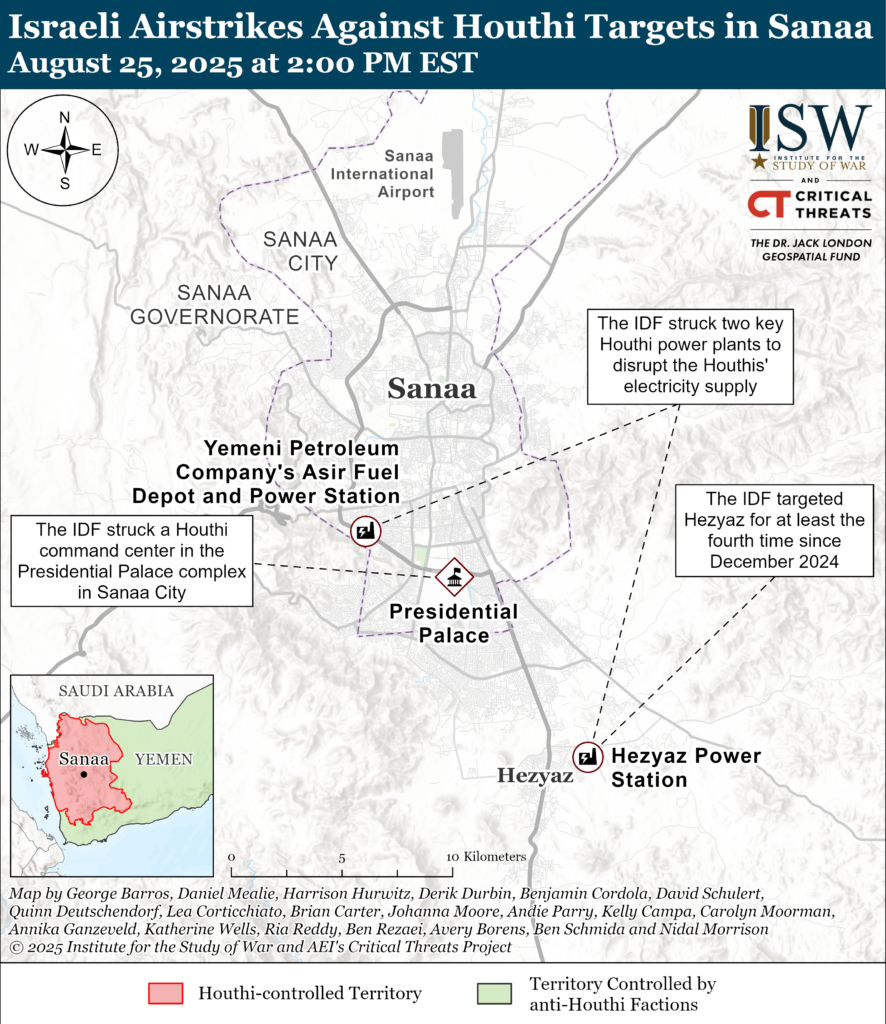
Palestinian Territories and Lebanon
Israel reportedly rejected US Special Envoy Thomas Barrack’s proposal to disarm Hezbollah but agreed to gradually halt its operations in Lebanon if the Lebanese Armed Forces (LAF) makes progress toward disarming Hezbollah.[77] The US proposal includes an Israeli withdrawal from its five permanent positions in southern Lebanon within 90 days and the full disarmament of Hezbollah by the end of 2025.[78] Israel has rejected previous proposals that would require Israel to withdraw from Lebanon before the Lebanese government disarms Hezbollah.[79] Israeli Prime Minister Benjamin Netanyahu’s office stated on August 25 that Israel would conduct “reciprocal measures” if the LAF takes steps to disarm Hezbollah.[80] Lebanese officials previously stated that the Lebanese government would not implement the US disarmament proposal until Israel agrees to the US proposal, however.[81] Israeli Strategic Affairs Minister Ron Dermer similarly told Barrack on August 24 that Israel would agree to withdraw from an unspecified number of its positions in southern Lebanon and gradually halt airstrikes.[82]
Dermer also told Barrack that Israel insists that an unspecified number of Lebanese villages on the Israel-Lebanon border remain evacuated to serve as a buffer zone between the two countries.[83] Dermer noted that Lebanon could develop factories and other industrial sites in the buffer zone.[84] The United States reportedly proposed a similar “economic zone” in southern Lebanon with Israeli officials on August 21.[85] Lebanese President Joseph Aoun noted that Lebanon is still waiting for Israel’s official response to the US proposal and has not been officially informed about Israel’s intended buffer zone in southern Lebanon.[86]
Hezbollah will likely use the formation of a buffer zone to justify retaining its weapons. Hezbollah’s objective since its formation in 1982 has been to expel foreign forces, including Israeli forces, from Lebanon and remove any “colonialist entity” from Lebanon.[87] Hezbollah maintains this objective and often cites continued Israeli operations in Lebanon as justification for retaining its weapons.[88] Hezbollah Secretary General Naim Qassem reiterated on August 25 that Hezbollah will not disarm and will not allow Israel to “roam freely” in Lebanon.[89] Qassem previously noted on August 15 that Hezbollah will not surrender its weapons until Israel halts its operations and withdraws from southern Lebanon.[90] Hezbollah parliamentarians have similarly stated that Hezbollah “could not” disarm while Israel continues to operate in Lebanon.[91]
Hezbollah is attempting to leverage regional support to pressure the Lebanese government to not implement its plan to disarm Hezbollah. Hezbollah asked Iraqi Shia Coordination Framework leaders on August 24 to pressure Iraqi Prime Minister Mohammad Shia al Sudani to halt Iraqi trade with Lebanon in response to the Lebanese government’s decision to disarm Hezbollah, according to unspecified Iraqi political sources.[92] The Shia Coordination Framework is a loose coalition of Iraqi Shia political parties, some of which Iran backs. Sudani is unlikely to fulfill this request given his recent efforts to strengthen Iraq’s economic relations with Lebanon.[93] Iraq has several economic agreements with Lebanon, including a $20 million reconstruction agreement and a fuel agreement.[94]
Hezbollah called on its supporters on August 25 to protest against the Lebanese government as part of its ongoing efforts to delay or reverse the government’s plan to disarm Hezbollah.[95] Hezbollah’s Central Trade Union and Hezbollah-allied Amal Movement’s Central Labor Office called on members to protest in Beirut on August 27 to affirm the status of Hezbollah and reject the government’s decision.[96] This statement marks the first time that Hezbollah has called for protests against the government’s decision.[97] The offices later postponed the protests to allow for dialogue.[98] Hezbollah officials have continuously threatened potential confrontation and anti-government protests if the Lebanese government attempts to disarm Hezbollah.[99] Hezbollah Secretary General Naim Qassem threatened on August 15 to “confront” the government and incite protests against it.[100] Saudi media reported on August 24 that Hezbollah informed Lebanese President Joseph Aoun and LAF Commander Brigadier General Rodolphe Haykal that the Lebanese government’s implementation of the disarmament plan would cause confrontation.[101] Hezbollah Political Council Deputy Head Mahmoud Qamati similarly warned on August 25 that Hezbollah supporters will form a “popular tsunami” to challenge the government’s decision.[102]
 Eurasia Press & News
Eurasia Press & News
